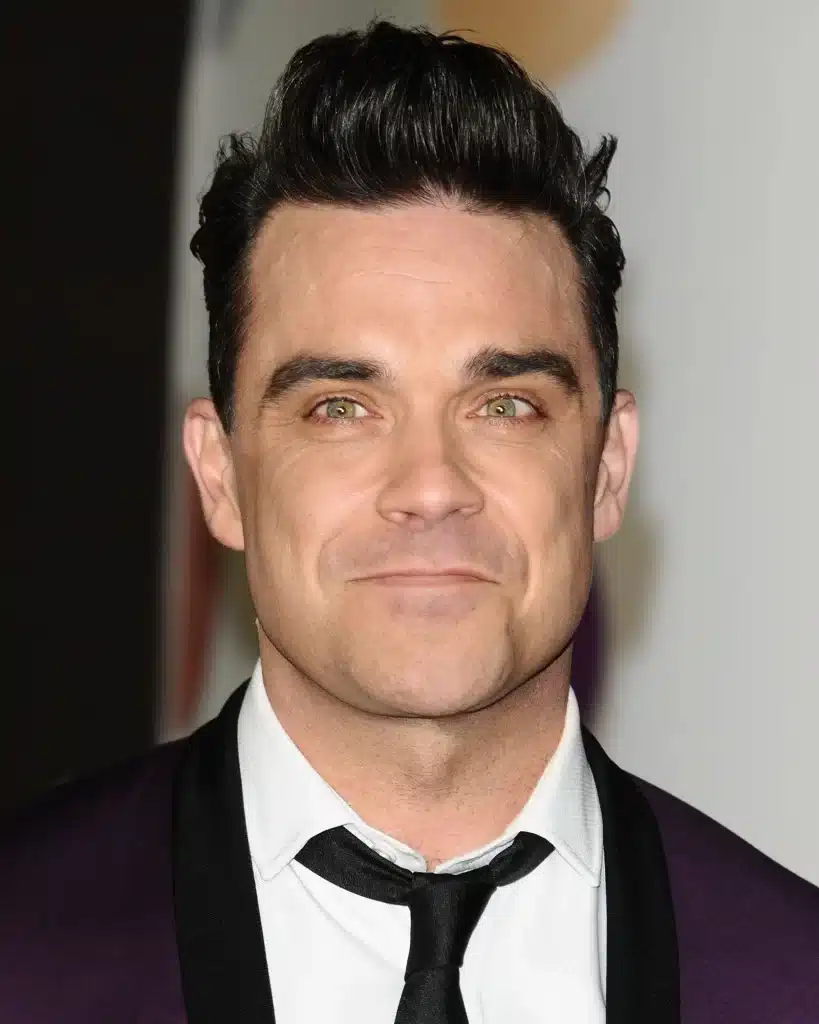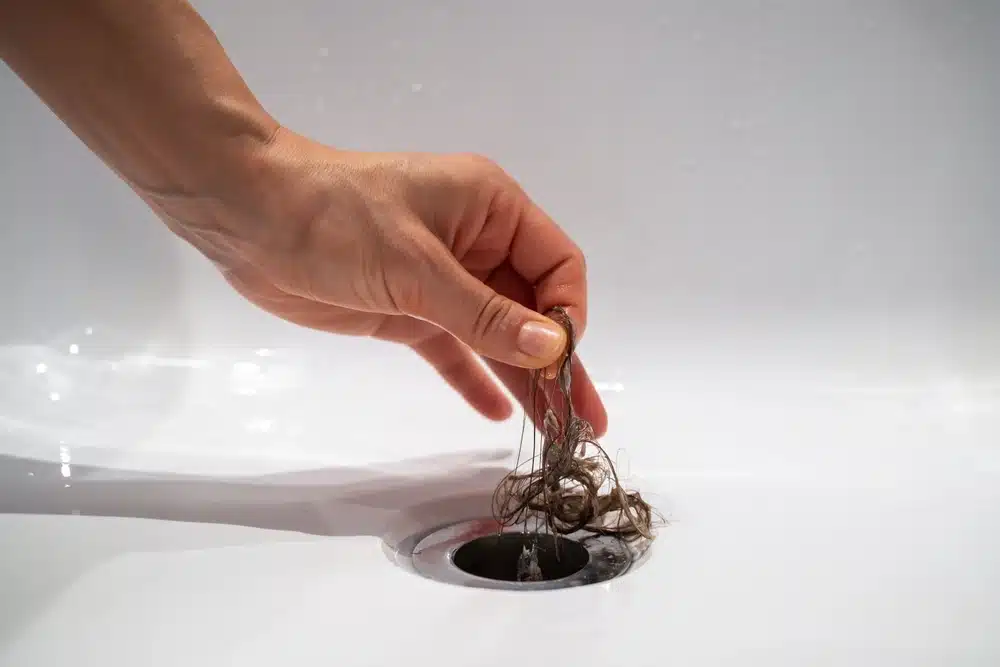It’s not uncommon for celebrities to get cosmetic procedures during their careers. After all, being a celebrity means being in the public eye, so they want to look good at all times.
Alongside rhinoplasty and botox, a common cosmetic procedure is a hair transplant, particularly for male celebrities who suffer from male pattern baldness. [1] One celeb who opted for this is Robbie Williams.
All About Robbie Williams
Robbie Williams is a well-known English songwriter and singer, gaining a high level of fame in the UK for his multiple hits, including Angels, Patience, Feel, and Rock DJ. He’s enjoyed a very successful career in the spotlight, with his good looks certainly helping him appeal to his audience!
Arguably Robbie’s most famous years were the late 1990s to the 2000s, which is when he was consistently seen in the charts. He’s still doing well, though – nowadays, fans can get tickets to see Robbie Williams perform in stadiums worldwide.
Did Robbie Williams Get a Hair Transplant?
There’s no doubt that Robbie Williams benefited from his good looks. While his songwriting and singing ability were always undoubtedly the highlight of his talents, he also acquired a loyal following of fans who loved his appearance just as much! So, it’s not a massive surprise that Robbie cared about his looks and – yes, opted for a hair transplant in 2013 when he started shining on the top.
Robbie Williams’ Hair Loss Throughout the Years
To understand why Robbie Williams got a hair transplant – and to see whether it was successful – it helps to look at his hairline over the years.
Robbie Williams’ Hair: 1990s
The 1990s were the beginning of Robbie Williams’ rise to fame. During this decade, he joined Take That, alongside members Gary Barlow and Mark Owen. During this time, he had thick, luscious hair – no sign of male pattern baldness at this stage.
Robbie Williams’ Hair: 2000s
In the 2000s, Robbie William had separated from Take That. It was during this time that he embarked on a very successful solo singing career. If you look at Robbie Williams’ hairline during these years, you’ll see that he still enjoys thick, dark hair, but there is a small amount of hair loss at the temples, which is very common in men as they age. That is likely why he decided to get a hair transplant just a few years later.
Robbie Williams’ Hair: 2013
Robbie Williams had a hair transplant in 2013. Usually, this leads the hair to grow back much thicker, but that didn’t occur in Robbie Williams’ case; his hair didn’t change much after the procedure. Little is known about the hair transplant itself – the ins and outs of the procedure are not public knowledge, so we cannot say what type of hair transplant he got or which clinic he went to. All we know is that it wasn’t a success, and the hair follicles didn’t take to his scalp.
Robbie Williams’ Hair: 2020-Today
Robbie Williams has more years behind him than when he first dropped onto the scene in the 1990s. Nowadays, as a man in his 50s, he can be seen with short, receding, thinning hair – an enormous change from how he looked a few decades ago. It isn’t all bad news, though – while he has been losing his hair, he has decided to embrace that, stating: [2]
“It’s getting thinner and thinner. No one will give me a thatch job [hair transplant] because they say my hair is too thin”.
Clearly, Robbie Williams is not a good candidate for a hair transplant now because of his thin locks. He also went on to say that we’ll have to embrace Robbie Williams losing his hair. Clearly, he knows he cannot fight genetics and, instead of trying out several other hair restoration techniques like Finasteride pills, will instead embrace his thinning locks.
It’s great to see that his hair loss isn’t bringing him down. In fact, he’s still able to experience fun hairstyles, including a Mohican.
Why Wasn’t Robbie Williams’ Hair Transplant a Success?
It’s hard to say exactly why the hair transplant wasn’t successful, but we can take a couple of guesses. First, Robbie Williams clearly didn’t need a hair transplant when he got one back in 2013 – his hair loss wasn’t that significant, which is perhaps why the hair follicles didn’t take. Maybe if he waited a little longer, the results would have been more significant. There’s also the possibility that his donor area wasn’t thick enough. For a hair transplant to be successful, the patient needs a donor area (usually on the scalp) of healthy hair. If a patient doesn’t have this, the procedure is less likely to go well.
As we don’t know the details about his hair transplant, it’s difficult to say what went wrong. He could have ended up in the hands of an unskilled hair transplant surgeon, which is why it’s so important to do your research and choose a clinic that has a high success rate.
Can a Hair Transplant Be Successful?
Yes! Many people – celebrities and otherwise – get successful hair transplants all of the time. While sometimes hair transplants do not end successfully, that doesn’t mean it has to include you. If you want examples of hair transplants that have given excellent results, check out our patients gallery.
Celebrities Who Have Had Successful Hair Transplants
There are many celebrities who have enjoyed the benefits of a hair transplant! That includes many footballers, including Wayne Rooney, who has been very open about his hair transplant experience and how it helped him regrow his hair and restore his confidence. Some other celebs with hair transplants include:
- Rob Brydon
- James Nesbitt
- John Travolta
- High Laurie
- Jimmy Carr
Hair restoration surgery has helped many celebrities over the years. It’s good to know that Robbie Williams’ experience doesn’t reflect the industry as a whole – it’s a simple case of an unsuccessful procedure, which can happen occasionally.
Is a Hair Transplant Right for You?
Of course, you don’t want to be like Robbie Williams in 2013 – spending money on a hair transplant you do not need. That’s why it’s so important to figure out whether you are a good candidate or not. The best candidates for hair transplants are those who are healthy, over 25, have experienced significant hair loss, and have a decent donor area on the scalp. It’s best to speak to a professional hair transplant surgeon to see if this hair loss treatment is right for you.
What Causes Hair Loss?
Many things can cause hair loss – the key to hair restoration is knowing the underlying cause. For many, it’s a simple case of genetics, but it can also be a nutritional deficiency or alopecia. It’s best to speak to a doctor about it.
What About Other Hair Restoration Techniques?
A hair transplant is not the only way to help regrow your locks. While it’s a good option for many people who have experienced hair loss, there are other ways to restore confidence. Here are some alternatives to a hair transplant:
Minoxidil
One of the most popular methods for fighting hair loss is using Minoxidil. This is a sort of topical medication (although you can find it in pill form) that triggers the hair follicles to regrow hair. It’s helpful for men with male pattern hair loss, but it works for women, too.
Finasteride
Another hair loss medication is finasteride. This one usually comes in the form of oral medication and is specifically prescribed to men with prostate issues. It can be prescribed for treating hair loss (and is very effective for many), but it’s unavailable under the NHS for this reason.
Wigs
While wigs won’t help you grow back your natural locks, they can look natural. Robbie Williams even talked about the possibility of wearing hairpieces, saying there are great wigs available. [2] We think a Robbie Williams hair piece would look fantastic! For best results with a wig, it’s best to see a professional hairdresser who can fit it properly and make it look natural.
Low-level Laser Therapy
Low-level laser therapy is a non-invasive hair restoration method that involves using light to trigger the hair follicles. You would usually get this done at a clinic, with just a couple of sessions helping patients regrow their hair.
Hair Oils
Some hair oils are known for their hair-growing properties, such as pumpkin seed oil and rosemary oil. However, consider that these hair oils likely won’t produce miracles – it’s always best to speak to a hair professional if you’re experiencing significant hair loss.
Get in Touch with the Clinic Today
At Harley Street Hair Clinic, we offer expert advice to all our clients. Whether you are interested in getting a hair transplant or want to learn more about the procedure, we can assist you. Download our excellent hair track app, which gives you access to all our services, including free, no-obligation consultations with our expert team. Start your hair-growing journey today!
Sources:
- https://www.aad.org/public/diseases/hair-loss/treatment/male-pattern-hair-loss-treatment
- https://www.standard.co.uk/showbiz/robbie-williams-hair-loss-at-48-failed-hair-transplant-follicle-growth-injections-b1016250.html





